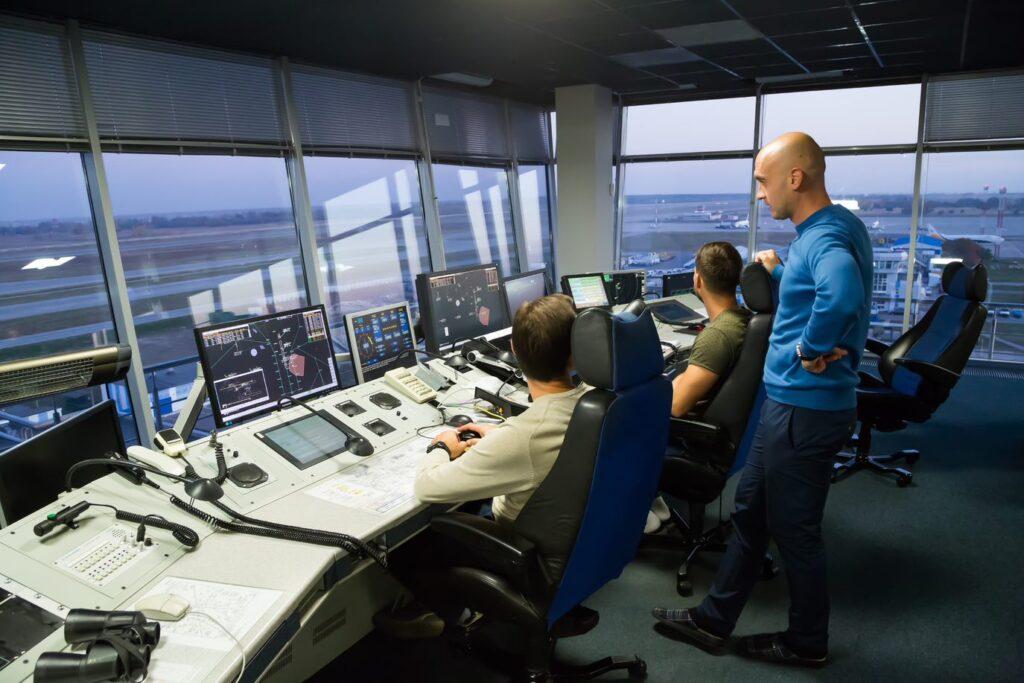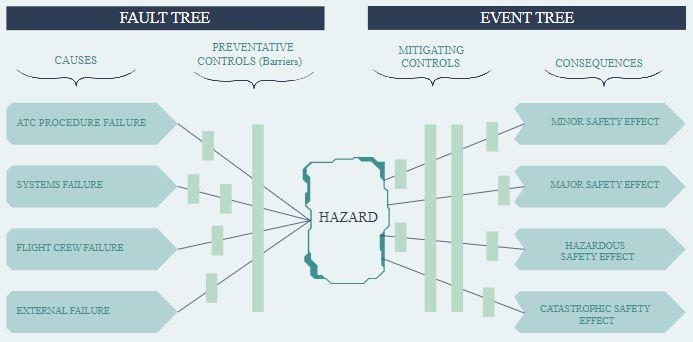Safety Policy
Safety Promotion
Risk Management
Safety Assurance
Compliance and Certification
Aviation Safety Management Systems
ICAO states that “Within the context of aviation, safety is the state in which the possibility of harm to persons or of property damage is reduced to, and maintained at or below, an acceptable level through a continuing process of hazard identification and safety risk management.”

Meeting and maintaining compliance with Air Traffic Management safety targets is a complex business. Safety requirements are derived from analysis that must integrate the impacts on multiple actors in a variety of airport environments and apportion the necessary mitigating strategies on a range of domains, systems and components.
There are various industry guides and regulations on Safety Management Systems. In Europe, EASA provides a substantial set of regulations such as the 1035/2011 implementing regulation (soon to be replaced by the 373/2017 in 2020).
ICAO provides Annex 19 and supporting guidance and the CANSO standards of excellence are prime examples.
AVISU has international expertise and experience that is at the cutting edge of safety analysis practices and models that are compliant with, and accepted by, the world’s major safety authorities. AVISU’s intelligent airport simulation and analytics tool, AVISIM, performs assessments and ‘what-if’ analyses under these criteria.
Safety Policy
The UK Civil Aviation Authority states that “The safety policy outlines the aims and objectives that the organisation will use to achieve the desired safety outcomes. It should declare the principles and philosophies that lay the foundation for the organisation’s safety culture and be communicated to all staff throughout the organisation.”
The development of an organisations safety policy is a key component in the safety management system. Management commitment and a clear establishment of responsibilities and accountabilities from top to bottom is essential in ensuring a safe culture.
Business human resource processes selection must integrate safety as a key skill, particularly for staff involved in the provision of services and oversight of the organisations safety management system. Safety is not something that is monitored, it is something that is core to the Air Traffic Management environment.
Even with robust and continuous structures and procedures in place, failures can sometimes occur. A safety policy must ensure that appropriate and measured contingency and emergency response capabilities are developed, implemented and practised.
Safety Promotion
The European Aviation Safety Authority states that “Safety promotion is a set of means, processes and procedures that are used to develop, sustain and improve aviation safety through awareness raising and changing behaviours.” At its core is a systematic approach to ensuring safety as a core value in the organisation. The safety policy may very well clarify the importance of safety, however instilling and motivating staff to understand and integrate it in their everyday procedures is another thing.
Methods to promote safety are diverse and include tailored training and communication strategies covering face-to-face forums, computer-based training, brochures, bulletins and publications, safety events and open forum discussions. AVISU believes there is no one size fits all, but an imaginative and engaging approach is the most valuable and inspiring way to promote the benefits of a safe organisation.
Risk Management
The SMS component covering risk management is probably one of the most complex practical applications that organisations can struggle with. Often, staff believe this element is only performed by highly experienced safety practitioners, but a truly safe organisation ensures risk management is understood and applied by all staff.
The key activities of Safety Risk Management (SRM) cover:
- Understanding the environment that the organisation is operating in.
- Mapping the system and service to the environment
- Hazard identification
- Assessing the current risk
- Mitigating the effects as low as reasonably practicable
AVISU has substantial experience in the risk management processes including developing processes and procedures, and establishing, verifying and validating system safety requirements to ensure all staff can perform the various levels of necessary SRM.
“The majority of runway incursions involve a failure to follow air traffic control instructions…In over 90 per cent of the incursions, Air Traffic Services noticed the problem, and the situation did not become more serious.” — EUROCONTROL Runway Safety
The following graphic is a typical bow tie model where internal and external failures are identified as potential causes of hazards. The various effects are derived and analysed in respect of the different internal and external mitigations available.

Safety Assurance
The Federal Aviation Authorty states that safety assurance “evaluates the continued effectiveness of implemented risk control strategies and supports the identification of new hazards.”
The process of safety assurance is a proactive one and requires well established procedures and systems to identify the relevant safety performance indicators when monitoring in both real time and the assessment of historical analysis to identify trends.
The Air Traffic Management systems of today are more and more designed to be upgradeable and responsive to the changing requirements and concepts of the industry. Safety Assurance ensures these changes are managed in a safe and efficient manner.
Finally, the assurance process is always looking for continuous improvement through its proactive operational audits and review incidents; and reacts to under-performing systems or procedures in order to identify the cause, map current safety cases and identify problems.
Safety Management Regulation Compliance and Certification
To obtain certification against a regulators requirement an organisation must understand the concept of what safety is. The regulations provided by local oversight authorities will give a set of requirements on organisational structure and assurance procedures such as quality, software, engineering, risk management, incident reporting, contingency arrangements and so on. However, the certification process is not just about meeting regulators requirements, it’s also about enacting a change within the organisation where a no-blame culture exists to enhance the performance of the business.
The common interpretation that safety requirements conflict with business requirements is not correct — they are mutually beneficial when the business is considered in a holistic fashion and true change management principles are adopted early on.
AVISU is one of the select few support companies that has been involved in the whole certification lifecycle of:
- Implementing a complete safety case development for an entire Air Traffic Management service delivery
- Identifying, selecting and monitoring compliance to service safety regulations
- Implementing an organisation-wide Safety Management System
- Cooperation and coordination with safety regulators globally
- Supporting a safety culture change throughout the organisations with training
